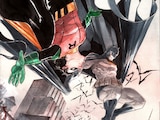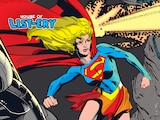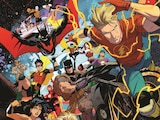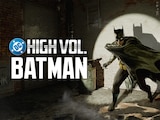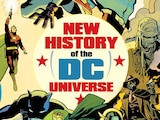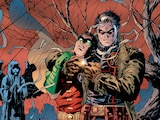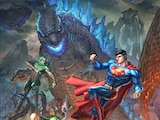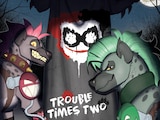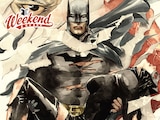Comics have always had a bit of a rebellious streak.
Whether it was the myriad of ways publishers conceived to get around the Comics Code, the cultural criticism found in some of the medium’s most acclaimed books, or even the fact that superheroes operate outside the law, comic books have never shied away from breaking the rules and have always been a voice against oppression and injustice.
SCARLET, the popular Jinxworld series from Brian Michael Bendis and Alex Maleev, fully embraces this tradition. With its story of a new American Revolution and its fourth-wall breaking protagonist, Scarlet has never been a series about doing what you’re supposed to, a tradition that continues today as the book returns with a new issue #1 and a new publishing partner. Scarlet is technically the second Jinxworld comic to be released since Bendis became exclusive to DC, but it’s the first Jinxworld book that had life before DC. Today’s SCARLET #1 is technically the eleventh issue of the series. There’s no reason that you can’t start with it, but you might want to know a bit more about this timely piece of revolutionary fiction before you do.

“Scarlet is about a young woman whose life was completely destroyed by the act of a corrupt police officer in Portland, Oregon,” Bendis shares. “The actions of the cop were covered up and her life was ruined, but instead of buckling to it, she fought back and became a very dangerous counter-culture media sensation. Eventually, she starts a revolution, right in the streets of Portland.”
Considering today’s world of mass protests and resistance, it’s not hard to imagine a story like Bendis and Maleev’s actually coming to pass, and interestingly enough, Scarlet was partially inspired by a real-life incident, as well as the famously progressive city that Bendis calls home.
“Right now, we’re a Portland book,” he shares. “It takes place here. And why it takes place here is that in Portland, we care. I was startled by how often the city would be shut down by protests into the deep night. I’m talking about pre-Obama, and during Obama, and now. People have now seen headlines. It was the idea that if the new American Revolution ever happened, and we woke up and learned that it started here in Portland, we wouldn’t be surprised.
“So, that mixed with a real-life situation that I had witnessed was what inspired this entire book. The idea was to write a comic that, like Paddy Chayefsky’s Network, was so crazy that you couldn’t even imagine that it was real. That’s what I was aiming for. Then I found out that I was only about four months ahead of the curve.”

The series first debuted eight years ago, in 2010, but it’s become more relevant with time, something the creative team is very aware of. Scarlet Rue is a fictional heroine who isn’t based on anyone in particular, but considering how much anger can be found in modern day society, it’s not hard to imagine someone a lot like her emerging in real life.
“Almost all heroes are unlikely,” Bendis suggests. “Scarlet is someone who would never have gone down this road if not being randomly pushed by a bad person. We’ve now spent years watching, on a daily basis, video after video of someone abusing their power, abusing their privilege to oppress someone. Eventually, it’s going to be the wrong f**king person. I’d witnessed something that I thought was going to go that way, and it didn’t, but it inspired me to think about what would happen if it did. What will it take? And really, what it’s going to take is just the wrong person at the wrong time.”
But Scarlet isn’t just forward thinking in its story—it’s entire presentation aims to move the comics bar forward. Maleev’s color palette is muddied and dim, fitting for its battlefield setting. However, he uses brighter color to really add impact to important characters or moments, whether it’s an explosion, a spurt of blood or Scarlet’s crimson hair. Even more noteworthy, however, is the way that Scarlet breaks the fourth wall and talks directly to the reader (indicated by square word balloons and italicized text). While other comics that break the fourth wall usually use the technique for comedy, Bendis and Maleev rely on it to really give the reader an understanding of who Scarlet is and why she’s doing everything she’s doing. You get to know her really well, really quickly.

“You are very much her best friend,” reveals Bendis. “You are involved in this. You’re not an innocent bystander enjoying it. She is making hard choices with you, and including you in them. That is an idea that I’d been dying to do for years. I just wanted to have the right story to do it. I thought that Scarlet’s moral ambiguity—the place that she’s in right now—is a fascinating place to put a reader, almost against their will.”
It’s something that Bendis had been interested in and experimenting with for a while, ever since he saw a similar technique used extremely effectively in an Aaron Sorkin play. However, to use it in a superhero comic didn’t feel right.
“For years, I toyed with it until Scarlet,” he continues. “The way she communicates with the reader was a choice that I hadn’t seen before. It challenges me as the writer, but it also challenges the reader to completely invest in her. She’s showing you everything. There’s nothing hidden. That’s a very unique place for a narrator to be.”
In short, Bendis and Maleev have created one of comics’ most engaging protagonists and set her in an entirely gripping—and all-too-plausible—scenario. Scarlet asks the age-old question of what happens when someone finally gets pushed too far, only to take that person in a surprising direction. For readers who might be tired of playing by the rules, both in life and in comics, it offers much to consider.
As Bendis succinctly puts it, “This is a young woman who has called for revolution in an American city and it’s happening live.”
SCARLET #1 by Brian Michael Bendis and Alex Maleev is now available in print and as a digital download.






